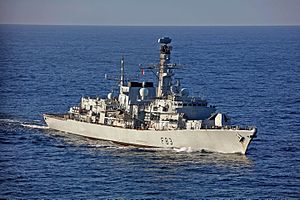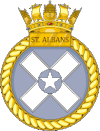HMS St Albans (F83)

In 2017, showing upgraded Mod 1 main gun
|
|
| History | |
|---|---|
|
|
|
| Name: | HMS St Albans |
| Operator: | Royal Navy |
| Ordered: | February 1996 |
| Builder: | Yarrow Shipbuilders |
| Laid down: | 18 April 1999 |
| Launched: | 6 May 2000 |
| Commissioned: | 6 June 2002 |
| Refit: | Major 2013-2015 |
| Homeport: | Portsmouth |
| Nickname(s): | "The Saint" |
| Status: | in active service |
| Badge: |  |
| General characteristics | |
| Class and type: | Type 23 Frigate |
| Displacement: | 4,900 t (4,800 long tons; 5,400 short tons) |
| Length: | 133 m (436 ft 4 in) |
| Beam: | 16.1 m (52 ft 10 in) |
| Draught: | 7.3 m (23 ft 9 in) |
| Propulsion: |
|
| Speed: | In excess of 28 kn (52 km/h; 32 mph) |
| Range: | 7,500 nautical miles (14,000 km) at 15 kn (28 km/h) |
| Complement: | 185 (accommodation for up to 205) |
| Electronic warfare & decoys: |
|
| Armament: |
|
| Aircraft carried: |
|
| Aviation facilities: |
|
HMS St Albans is a Type 23 frigate of the Royal Navy. She is the sixth ship to bear the name and is the sixteenth and final ship in the 'Duke' class of frigates. She is based in Portsmouth and since December 2016 her captain has been Commander Chris Ansell.
The ship was launched on the River Clyde on Saturday 6 May 2000. She was built at BAE Systems' Yarrows Yard in Scotstoun, Glasgow.
On 27 October 2002, before entering operational service, St Albans was struck by the P&O ferry Pride of Portsmouth when gale force winds pushed the ferry into the ship whilst secure on her berth in Portsmouth. St Albans suffered damage to the gun deck, the sea boat supports (davits) and the bridge wing. However, no members of the crew were injured. In 2004, Commander Steve Dainton RN took command and the ship was deployed on Operation Oracle duties in the Arabian Sea. In July that year the crew were granted Freedom of the City by the Mayor of St Albans.
On 13 February 2006, St Albans departed on a six-month deployment to the Gulf region. She arrived in the region in early April, where her tasks included protecting Iraqi oil platforms as well as patrol duties in the northern Gulf. During the trip, she provided a diplomatic role by visiting 16 countries, including Algeria, Albania, Ukraine, Romania, Bulgaria, Turkey and Lebanon. By 12 July 2006 she had completed her tour in the Gulf and had begun her long journey back to Portsmouth via the Suez Canal and the eastern Mediterranean. However, on the same day, the conflict between Israel and Lebanon began. As a result, the Ministry of Defence announced on 17 July that year that St Albans had been redeployed to assist in Operation Highbrow, the evacuation of British citizens trapped in Lebanon. She arrived in the area on 20 July and the following day picked up 243 evacuees from the dock in Beirut and safely transported them to Cyprus. After completing her role in the evacuation, she remained on operational stand-by in the vicinity of Beirut for a short time before being resuming her voyage home. The ship finally arrived back in Portsmouth on 18 August 2006.
...
Wikipedia
